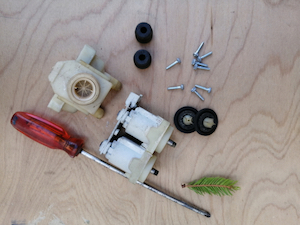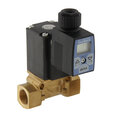How To Clean a Solenoid Valve

Figure 1: A solenoid valve from a washing machine disassembled for cleaning and repair.
Solenoid valves control flow in industrial and commercial applications. Over time, solenoid valves may be clogged with debris, contaminated with impurities, or corroded by certain materials. In these cases, the valve's performance is compromised, reducing flow rates, leaks, and other issues.
Solenoid valves' optimal function can be maintained by routine cleaning, which helps prevent unexpected failures and extends their useful life. This article further discusses why solenoid valves should be cleaned, how to clean them, and which cleaning materials are appropriate. Learn more about these valves by reading our solenoid valve overview article.
View our online selection of solenoid valves!
Why clean a solenoid valve
The following situations indicate that a solenoid valve may need to be cleaned:
- Reduced flow rate: If the valve's flow rate is lower than intended, the valve may be clogged with debris or contaminants.
- Leakage: If the valve leaks in the closed position, it's possible that it cannot close entirely due to clogging.
- Unusual noises: If the valve is whining or buzzing, it may be clogged.
- Erratic operation: If the valve doesn't open and close when it should or opens and closes randomly, the valve may be clogged.
Other reasons to clean a solenoid valve
The other reasons to clean a solenoid valve are:
- Contamination: The particles and impurities in contaminated media can accumulate and clog the solenoid valve.
- Corrosion: Metals prone to corrosion, such as iron or steel, can corrode over time, causing the valve to stick or fail to operate. Cleaning the valve can remove corrosion.
- Maintenance: Solenoid valve cleaning can be part of routine maintenance to ensure the valve remains at peak efficiency for as long as possible.
Read our solenoid valve troubleshooting article for more details on repairing solenoid valves.
Steps for cleaning a solenoid valve
Before beginning the cleaning process, refer to the solenoid valve's manual for guidance on the specific tools necessary to complete the job. In general, however, the cleaning process follows these steps:
- Disconnect the solenoid valve from its power supply.
- Disconnect the inlet and outlet connections to remove the valve from the system.
- Carefully take the valve apart. Remember the location and orientation of each part, but for more thorough information to disassemble or assemble the valve, please refer to your valve's manual.
- Clean each solenoid valve component with a suitable cleaning solution (see next section). Do not use harsh chemicals or abrasives, as these can damage the valve.
- Completely rinse each part with clean water to ensure no cleaning solution residue remains.
- Inspect the individual parts for damage or wear and replace parts that cannot be repaired.
- Read our article on o-ring installation and replacement to determine if any of the valve's o-rings need to be replaced.
- Carefully put the valve back together. Ensure that each part is in the correct orientation and that all seals and o-rings are properly installed.
- Reinstall the solenoid valve into the system. Ensure the inlet and outlet connections are aligned correctly and are tightened to the appropriate torque.
- Connect the power supply back to the solenoid valve and test it to ensure it functions correctly.
- Monitor the solenoid valve for several days. Make sure it is functioning correctly and has no leaks.
Cleaning material for solenoid valves
Plastic and rubber components
Use a mild detergent to clean plastic and rubber components (e.g., o-rings and the diaphragm of an indirect solenoid valve). Check with the manufacturer to determine if there is a specific water-to-detergent ratio recommended for the particular solenoid valve. If not, a general rule is approximately 10 ml of detergent for each liter of water (1-2 tablespoons per gallon).
Metal components
Isopropyl alcohol is a suitable solvent for both stainless steel and brass components of a solenoid valve. Apply the solvent to a clean cloth or brush and gently clean the components.
Orifices
Blow compressed air through the small orifices (e.g., pilot valve orifice) to remove dust and debris. Wear safety glasses and gloves.
FAQs
What can I use to clean solenoid valves?
A solenoid valve can be cleaned with diluted detergent for the rubber components and isopropyl alcohol for the metal components. Scrub metal components with a soft metal brush.
Why do solenoid valves need to be cleaned?
Debris and impurities can accumulate in a solenoid valve, clogging it and preventing it from functioning normally. Also, some metals, like iron or steel, may corrode when exposed to certain substances.









